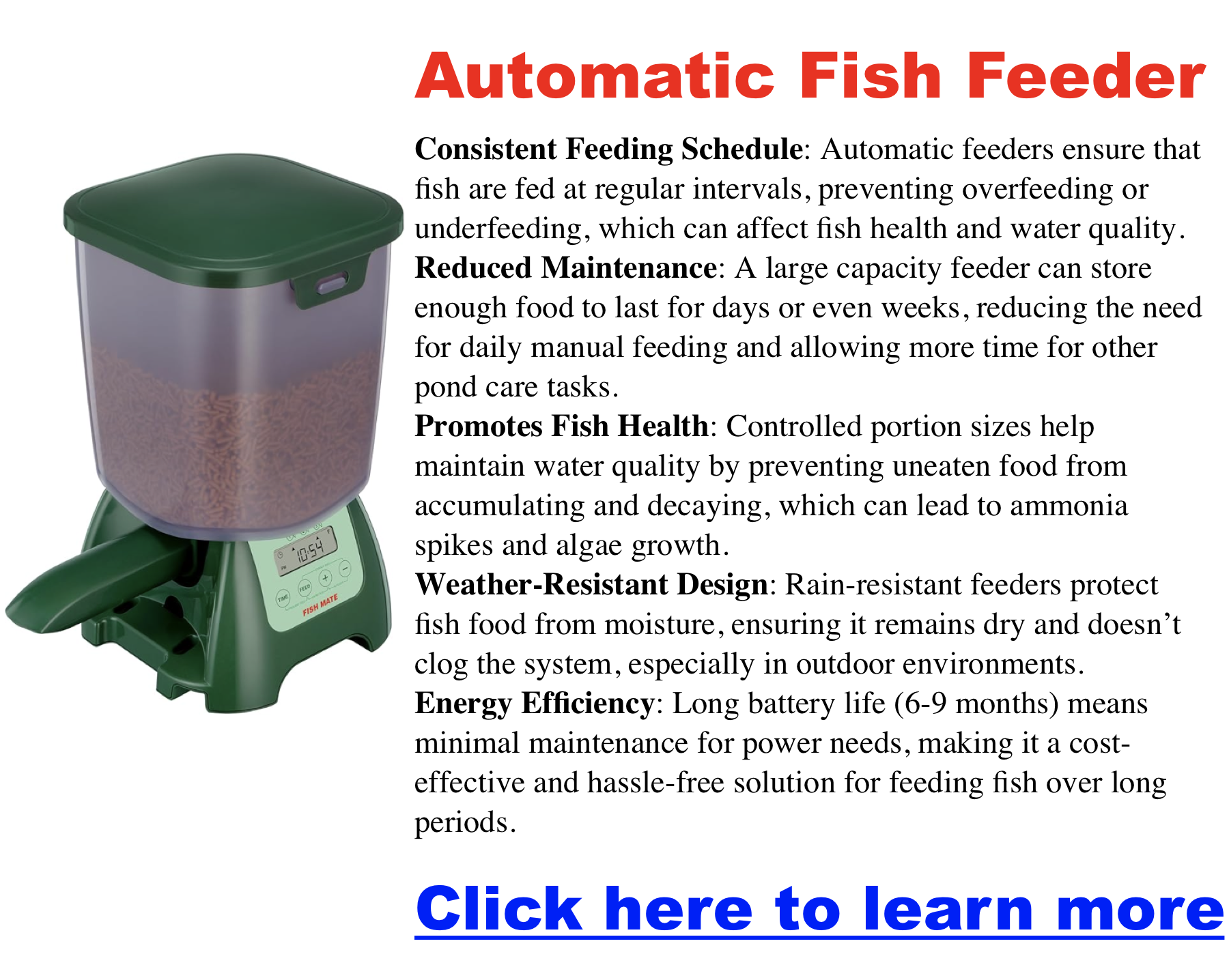Best Food For Pond Fish for Different Fish
Best Food for Pond Fish: A Complete Feeding Guide
Want brighter colors, healthier fish, and cleaner water in your pond? Feeding pond fish properly isn’t just about tossing in pellets—it’s about providing the right mix of nutrition, natural variety, and seasonal adjustments. This guide breaks down the best foods by fish type, feeding tips, and product picks to help your fish thrive.
📂 Quick Navigation: Best Foods for Common Pond Fish
| Fish Type | Natural Foods | Commercial Foods | Treats | Feeding Tips | |
|---|---|---|---|---|---|
| Koi | Aquatic plants, insects, plankton | High-protein pellets, sticks | Fruits (oranges, watermelon), shrimp | More protein in summer, less in winter | |
| Goldfish | Plankton, insects, small aquatic plants | Flakes, pellets | Chopped spinach, peas | Feed small portions 2–3 times daily | |
| Catfish | Worms, leeches, aquatic plants | Sinking pellets, high-protein sticks | Bloodworms, vegetable scraps | Use sinking food, feed at night or early AM | |
| Bluegill | Insects, larvae, plankton | High-protein pellets, flakes | Crickets, mealworms | Feed regularly, adjust portions seasonally | |
| Largemouth Bass | Smaller fish, worms, aquatic insects | Protein-rich pellets | Natural prey, earthworms | Minimal feeding if natural prey is abundant | |
| Sturgeon | Microorganisms, small fish | Sturgeon sinking pellets | Insect larvae, algae | Ensure food reaches bottom of pond | |
| Mosquito Fish | Mosquito larvae, small insects | Tiny flakes, micro-pellets | Supplement with flakes | Thrive on natural sources, feed occasionally |
🌟 Top Recommended Pond Fish Foods
| Rank | Product | Why It’s Recommended | Link |
|---|---|---|---|
| 🥇 | Hikari Gold Koi Food | Enhances color & digestion | Buy on Amazon |
| 🥈 | TetraPond Floating Food Sticks | Easy to digest, floats well | View Product |
| 🥉 | API Pond Fish Food Pellets | Balanced nutrition on a budget | See Deal |
| 👍 | Omega One Sinking Pellets | Ideal for bottom feeders | Check Price |
| 🌱 | Zoo Med Spirulina Flakes | Boosts plant-based nutrients | More Info |
📊 Feeding Table by Fish Type
🌍 Species-Specific Feeding Tips
Each fish species has different nutritional needs and feeding habits. These mini-guides help you feed them right:
🐟 Koi
- Loves: Aquatic plants, protein-rich pellets, fruits
- Best Pick: Hikari Gold Koi Food
- Tip: More protein in summer, switch to digestible food in winter
🐠 Goldfish
- Eats: Plankton, insects, flakes, chopped greens
- Best Pick: TetraPond Food Sticks
- Tip: Feed small portions multiple times daily
🐟 Catfish
- Forages: Bottom dwellers, loves sinking food
- Best Pick: API Pellets
- Tip: Feed after dark for best results
🐟 Bluegill
- Versatile feeders, enjoy insects and pellets
- Best Pick: Omega One Pellets
🐟 Largemouth Bass
- Predatory, eats smaller fish and worms
- Tip: Feed only if prey is low or during breeding
🐟 Sturgeon
- Ancient bottom feeders, need sinking food
- Best Pick: Sturgeon Pellets
🐟 Mosquito Fish
- Thrive on mosquito larvae
- Best Pick: Tiny Flakes
🌊 Types of Commercial Fish Food
- Pellets: Ideal for koi, bass, bluegill. Choose 40%+ protein.
- Flakes: Best for goldfish and mosquito fish
- Sticks: Good for surface feeders like koi
- Granules: Easy to digest in cold seasons
- Live food: Bloodworms, brine shrimp, daphnia (great for color + breeding)
- Freeze-dried: Krill, shrimp (nutrient boost)
- Specialty: Color-enhancing or slow-sinking options
🍓 Safe Treats & Feeding Variety
Add variety with healthy treats that boost color, vitality, and interest:
- Vegetables: Peas, spinach, celery
- Fruits: Orange bits, watermelon, mango
- Protein: Crickets, earthworms, ants
- Natural Boosters: Garlic (stimulates appetite), propolis (natural antibiotic)
🧬 How to Feed Pond Fish the Right Way
- Monitor Water Temperature
- Warm water = more food
- Cold water = reduce or stop feeding
- Avoid Overfeeding
- Only feed what fish can eat in 3 minutes
- Remove uneaten food to prevent pollution
- Feed by Behavior
- Surface feeders? Use floating sticks
- Bottom dwellers? Use sinking pellets
- Adjust Seasonally
- Spring/Summer: Higher protein
- Fall/Winter: Low protein or none at all
Recent Posts


